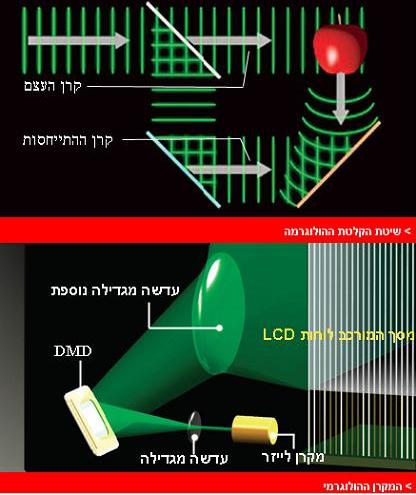You cannot hang the XNUMXD TV on the wall, but you will feel like you are right inside the screen.
Popular Sciences

Direct link to this page: https://www.hayadan.org.il/3dtv0905.html
Even if you had free entry to any of the best seats in the stadium, you still wouldn't see half of the activity you will see in your living room, in the not too distant future, on the big screen of the holographic television.
Without getting up from the armchair, you can watch all the games from any angle of view you want and look long into the depths of your television. The only thing that will be missing in the area will be the snack vendors.
Although this script is about a decade away, a small version of it already exists in the Dallas lab of 51-year-old Harold Garner, a physician, plasma physicist and biochemist at the University of Texas Medical Center. The prototype built by Gerner is the first device in the world that creates holographic films - truly XNUMXD - without special glasses or . . . nausea.
How did a man working at a medical center discover the key to describing holographic objects in motion? Gerner's research position in developmental biology at the University of Texas is partially funded by the founders of the Texas Instruments company, which allowed him from the start access to the DMD device - used in today's advanced video projectors. It consists of close to a million mirror plates, each of which can be tilted by a computer several thousand times a second to reflect light rays or deflect them, thus producing moving images. Gerner's brilliant idea was to bombard the DMD with a laser instead of a normal projection bulb. He programmed the DMD to reflect a sequence of two-dimensional interference that interrupts the laser light so that it reflects a three-dimensional hologram.
The hologram recording method
Garner's biggest challenge was finding a suitable screen. To convert the XNUMXD block images into truly XNUMXD images, the projection surface must have volume. A column of steam might do, as well as a goblet of antifreeze (jelly), but both would scatter the projected image and impair its sharpness. Garner therefore works with a display that is made up of layers of thin LCD panels, each of which can, when charged with electricity, brighten or dim. As the plates flash one after the other in rapid succession to form the hologram, the speed is high enough to convince the eye that it is seeing a three-dimensional body.
Such screens are already in use today, but currently lack the advantage of holography: they have to cut a XNUMXD image and send it, slice by slice, to LCD screens. The image comes very close to Garner's ambition, but the method demands greater processing capacity because X, Y and Z coordinates are needed for each slice. For this reason Garner's development is the most practical solution for XNUMXD television. It does not require a wider band than today's TV signals so we can take advantage of the existing broadcast infrastructure. To create holographic content, the broadcast would need to be recorded using a series of cameras that would shoot from different angles.
The first application of the technology that Garner develops may be in holographic imaging of MRI scans or in the military, in head monitors that project data (on airplanes for example) that can be read without taking your eyes off. It will be a while before we see basketball games on 2008D TV. By 2015, the technology is expected to enter military use, and by XNUMX, Garner hopes that it will be found in the living room of our home.
Three-dimensional television
Japan will probably be the first country in the world whose residents will be able to watch XNUMXD TV movies or sports broadcasts that will give the viewer at home the feeling as if he is really, really in the stands of the stadium.
The Japanese government has determined that 2020D television will begin operating in 10. The devices will allow viewing from any angle - even standing behind the device and watching the broadcast. For this purpose, a development budget of 3 million dollars was provided by the Japanese government to the developer companies. By the way: the Russians claim that they were the first to start planning a DXNUMX TV - but their project did not progress.
The Japanese venture is led by Toshiba. A television she developed includes technology in which photographs taken from different angles undergo computer processing to create a complete image for a XNUMXD display. But viewing is through special lenses. The more advanced idea talks about not needing special lenses or glasses for this experience.
The Japanese are now talking about a television set that will be placed in the corner of the room, but the 37D image will "float" on the ceiling, above the viewers. There are already monitors with sizes of 60 and 30 cm each that allow viewing angles of 480 degrees and guarantee an imaging resolution of 300 x XNUMX pixels.
Also in England, but without government budgetary support, scientists are developing state-of-the-art televisions that will broadcast in 11D. There is already a system that projects 64D x-rays to hospitals. Such a system takes XNUMX pictures of a patient's internal body organs in XNUMX seconds and creates a XNUMXD x-ray image on a monitor - for the needs of the doctor or surgeons when they come to plan an operation.
Another system that works on the same principle is ultrasound - for diagnostic tests of fetuses in the womb. Through it you see a fetus moving in the womb already when it is only 8 weeks old.
The connoisseur of technological futurism
https://www.hayadan.org.il/BuildaGate4/general2/data_card.php?Cat=~~~249187384~~~64&SiteName=hayadan
